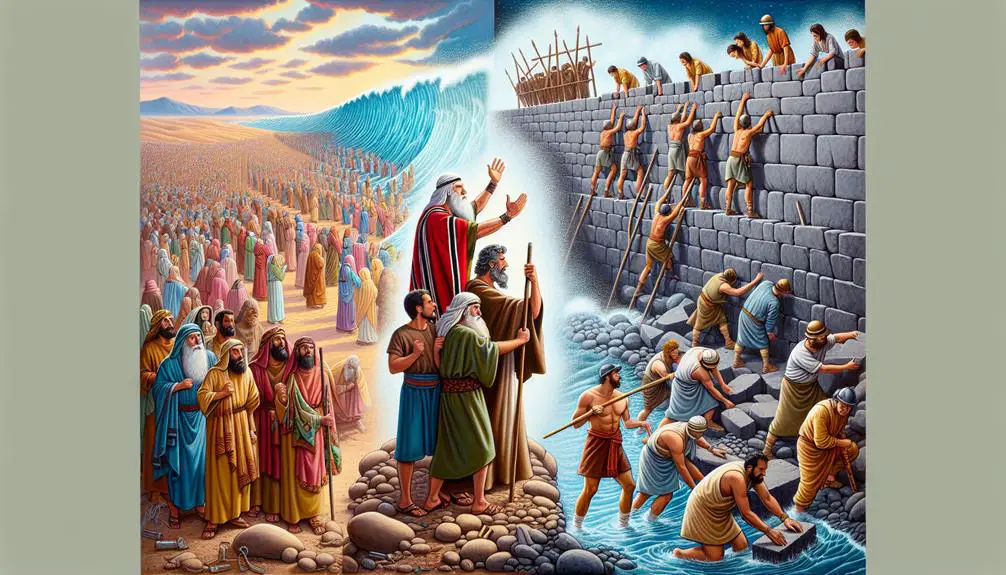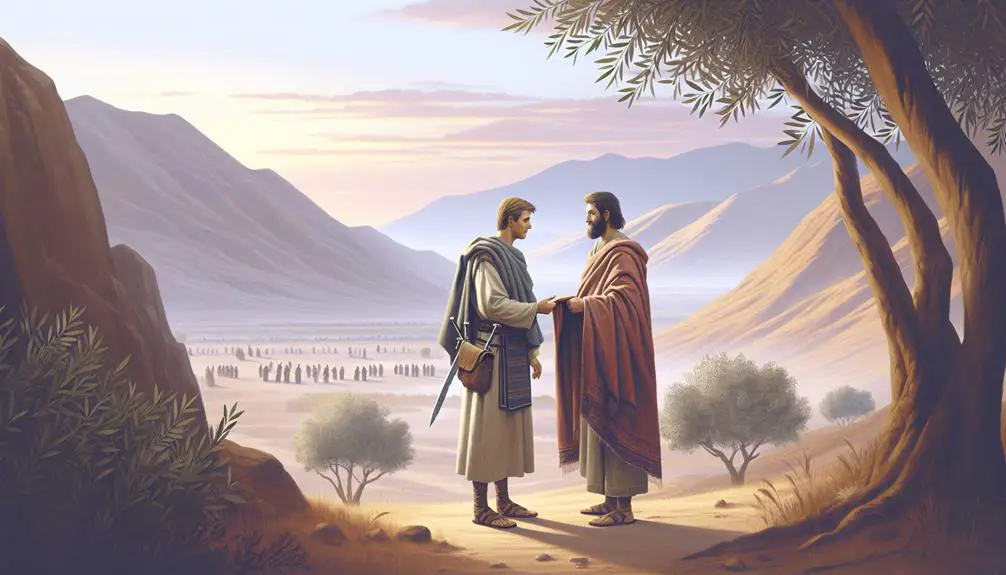Learn about the power of teamwork in the Bible, from Noah's ark to the walls of Jericho, and discover why unity is divine.

Examples of Teamwork in the Bible
In the Bible, tales of solitary faith mingle with profound examples of teamwork, illustrating that even in divine narratives, collaboration is key. You'll find Noah didn't build the ark alone; his family's support was crucial. Similarly, Moses led the Exodus, but it was a collective effort that saw the Israelites through their journey.
From the walls of Jericho falling through unified faith to Paul and Silas's partnership in prison, these stories underscore a fundamental truth: unity is strength. To grasp the full depth of these biblical team efforts, consider how they reflect on your own experiences with cooperation and collective resilience.
Key Takeaways
- The Bible showcases teamwork in varied contexts, from constructing Noah's Ark to spreading the Gospel by the Apostles.
- Successful biblical missions, like the Battle of Jericho, depended on strategic planning, unity, and divine guidance.
- Deep personal relationships and loyalty, exemplified by David and Jonathan, underline the importance of bonds in effective teamwork.
- Leadership and collaborative efforts, as seen in Nehemiah's rebuilding of the wall, highlight the value of shared goals and diverse contributions.
Building Noah's Ark

The construction of Noah's Ark exemplifies a remarkable instance of teamwork and obedience to divine command, as depicted in the biblical narrative. This monumental task not only required Noah and his family to possess exceptional carpentry skills but also an in-depth understanding of animal care. The Ark's construction is a testament to the collaborative effort involved in undertaking such an ambitious project. The narrative suggests that the successful completion of the Ark relied heavily on the harmonious integration of these skills, demonstrating an early example of project management and specialization.
Your analysis of this event should recognize the complexity of managing a project of this scale. The Ark had to be designed to withstand the floodwaters, implying that Noah's carpentry skills weren't just about construction but also about ensuring the safety and survival of his family and the animal species. The aspect of animal care is equally significant. It required a comprehensive understanding of the needs of different species to ensure their well-being during the confinement.
In essence, the building of Noah's Ark underscores the importance of teamwork, specialized skills, and obedience in accomplishing a divine mandate. This narrative highlights the synergistic effect of combining various competencies towards achieving a common goal.
The Exodus Journey

Shifting focus from the cooperative endeavor of building Noah's Ark, we now explore the Exodus Journey, another profound biblical narrative that underscores the importance of leadership, faith, and collective action in overcoming adversity. This story highlights Moses' leadership in guiding the Israelites out of Egypt, despite Pharaoh's defiance. Moses' ability to rally his people and confront Pharaoh's obstinance demonstrates a critical example of effective teamwork underpinned by unwavering faith and strategic guidance.
Aspect |
Significance |
|---|---|
Moses' Leadership |
Embodies the essence of vision, perseverance, and the capacity to inspire others. |
Pharaoh's Defiance |
Serves as the catalyst for the manifestation of collective resolve among the Israelites. |
Faith in Divinity |
Acts as the unifying force that sustains the morale of the group. |
Collective Action |
Highlights the power of unity in confronting and overcoming monumental challenges. |
Strategic Guidance |
Illustrates the importance of wise planning and execution in achieving a common goal. |
Through the Exodus Journey, the narrative delves into the complexities of human interaction, leadership dynamics, and the indomitable spirit of collaboration. Moses' leadership, in the face of Pharaoh's defiance, exemplifies how strong leadership and collective action can pave the way to overcoming seemingly insurmountable obstacles.
The Battle of Jericho

As you explore the Battle of Jericho, you'll find that strategic cooperation and divine guidance are pivotal themes.
This event illustrates how collective action, underpinned by faith, can lead to remarkable outcomes.
Analyzing these elements offers insights into the complexities of teamwork in a historical and spiritual context.
Strategic Cooperation
In exploring strategic cooperation within biblical narratives, the Battle of Jericho serves as a pivotal example of collective action guided by divine instruction. This event highlights the importance of collaborative leadership and mutual accountability among the Israelites.
The strategic cooperation seen here isn't just about following orders; it's about understanding the strength that lies in unity and shared responsibility. Every individual's role, from Joshua's leadership to the trumpeters and the silent marchers, was crucial. This narrative teaches you that successful outcomes often depend on the ability to work together towards a common goal, respecting each member's contribution.
Such a model of teamwork not only ensures the execution of tasks but also fosters an environment where trust and collective effort are valued above individual prowess.
Divine Guidance
Building on the foundation of strategic cooperation, the role of divine guidance in the Battle of Jericho reveals another layer of complexity within biblical narratives of teamwork. You'll see that guided decisions, underpinned by spiritual discernment, were pivotal. The Israelites, led by Joshua, adhered to divine instructions, demonstrating a profound trust in spiritual guidance over human logic. This instance underscores the integral role of faith and obedience in achieving collective goals.
Aspect |
Description |
Relevance |
|---|---|---|
Divine Command |
March around the city for seven days |
Guided decisions |
Spiritual Action |
Use of trumpets instead of conventional warfare |
Spiritual discernment |
Outcome |
The walls of Jericho fell |
Effectiveness of guidance |
This table epitomizes how divine guidance can steer a team towards accomplishing seemingly impossible tasks.
David and Jonathan's Alliance

Exploring the alliance between David and Jonathan reveals a profound example of teamwork that transcends mere political alliance, highlighting deep personal bonds and mutual respect within the narratives of the Bible. This unique relationship is underpinned by friendship loyalty and covenant bonds, serving as a benchmark for collaborative efforts. You'll notice that their bond isn't just a fleeting alliance but is deeply rooted in a commitment that challenges the conventional understanding of political and personal relationships of their time.
Analyzing their story, you'll understand that their teamwork is based on mutual support and protection, with Jonathan going to great lengths to ensure David's safety, even against his own father, King Saul's wishes. This act of loyalty underscores the strength of their covenant, a bond that's both sacred and profound. Their alliance stands out as a testament to the power of unity and loyalty, transcending the personal risks involved.
Through this lens, David and Jonathan's story offers valuable insights into the essence of true teamwork. It's not merely about achieving a common goal but about fostering a relationship built on trust, respect, and an unbreakable bond, setting a timeless example for collaborative efforts.
Nehemiah Rebuilds the Wall

Shifting focus to another remarkable instance of teamwork, Nehemiah's endeavor to rebuild the wall of Jerusalem exemplifies collective effort and leadership amidst adversity. When Nehemiah heard about the desolate state of Jerusalem's walls, he was moved to action, understanding the critical role these walls played in the city's defense and the morale of its people. His leadership galvanized a community effort that transcended social, economic, and professional boundaries, showcasing an unparalleled level of community involvement.
Here are key points that highlight the essence of their teamwork:
- Unified Vision: Nehemiah communicated a clear and compelling vision that united diverse groups towards a common goal.
- Strategic Planning: Careful allocation of resources and division of labor maximized efficiency and participation.
- Overcoming Opposition: Their collective resilience in the face of external threats and internal dissent was crucial.
- Community Involvement: Everyone, from priests to merchants, played a role, emphasizing the project's collective nature.
- Wall Dedication: The ceremonial dedication of the wall symbolized not just a physical achievement, but a spiritual and communal restoration.
Nehemiah's story is a testament to the power of leadership that fosters teamwork, demonstrating that collective efforts can overcome great challenges.
The Apostles Spread the Gospel

As you explore the efforts of the Apostles to spread the Gospel, it's crucial to recognize their unified mission strategy amidst their diverse backgrounds.
This collaboration highlights the strength found in a shared purpose, despite individual differences.
Examining this dynamic provides insight into the effectiveness of their collective action in disseminating their message across varied cultures and societies.
Unified Mission Strategy
In the early Christian era, the Apostles adopted a unified mission strategy to spread the Gospel effectively across diverse regions. This approach not only facilitated the rapid dissemination of Christian teachings but also underscored the importance of cultural integration and conflict resolution in their missionary work. By understanding and respecting the cultural contexts they encountered, the Apostles were able to communicate more effectively and resolve conflicts that arose, thereby fostering a spirit of unity and cooperation.
- *Cultural Integration*: Adapted teachings to resonate within different cultures.
- *Conflict Resolution*: Addressed and resolved disagreements, promoting unity.
- *Strategic Planning*: Identified key regions for spreading the Gospel.
- *Collaborative Effort*: Worked together, leveraging each other's strengths.
- *Communication*: Maintained open lines of communication for effective coordination.
Diverse Backgrounds Collaboration
The collaboration among the Apostles, hailing from diverse backgrounds, was instrumental in the effective spread of the Gospel across various cultures and societies. This diversity fostered a unique cultural synergy, enabling the message of Christianity to be contextualized for different audiences without diluting its core teachings.
By engaging in interfaith dialogues, the Apostles demonstrated an early form of religious diplomacy that respected the beliefs of others while confidently sharing their own faith. This approach not only expanded the reach of their message but also cultivated an environment of mutual respect and understanding.
Such a strategy underscores the importance of embracing diversity and leveraging it for collective goals, a lesson that remains relevant in today's globalized world.
Paul and Silas in Prison

Paul and Silas's experience in prison exemplifies the profound impact of teamwork under dire circumstances, demonstrating how mutual support and faith can triumph over adversity. Their story is a vivid illustration of prayer power and miraculous escape, highlighting the significance of collaboration in the face of trials.
- Unified Prayer: The collective prayer of Paul and Silas not only showcased their faith but also set a precedent for how teamwork can invoke divine intervention.
- Singing Hymns: Their choice to sing hymns together, despite their dire situation, serves as a testament to the strength found in shared belief and mutual encouragement.
- Miraculous Escape: The earthquake that freed them was a direct result of their unified faith and prayer, illustrating how teamwork can lead to divine breakthroughs.
- Impact on Others: Their unwavering faith and teamwork had a profound impact on the prison guard and his family, leading to their conversion. This demonstrates the wider influence that collective faith can have.
- Strategic Response: Even after their miraculous escape, Paul and Silas's strategic decision to reveal Paul's Roman citizenship highlights the importance of wise teamwork in navigating legal and societal challenges.
Analyzing Paul and Silas's story, it's evident that their combined faith, strategic actions, and unwavering support for each other underpin the power of teamwork in overcoming adversity.
Frequently Asked Questions
How Do Modern Scholars Interpret the Teamwork Displayed in These Biblical Stories, and What Are the Critiques?
Modern scholars interpret the teamwork in these stories through the lens of cultural adaptations and leadership styles. They often argue that these narratives reflect the evolving nature of collaboration and authority within their historical contexts.
Critiques focus on the potential anachronism of applying contemporary leadership theories to ancient texts. Scholars caution against oversimplifying these complex interactions, emphasizing the need for a nuanced understanding of the socio-cultural dynamics at play.
In What Ways Have These Examples of Teamwork Been Depicted in Art, Music, and Literature Throughout History?
You've seen how teamwork's depicted through artistic symbolism, musical adaptations, and literary references across history.
Art often uses symbolic imagery to convey unity and collaboration, while music adapts these narratives into harmonious compositions, reflecting the essence of teamwork.
Literature, on its part, analyzes and reinterprets these themes, offering fresh perspectives.
Collectively, they provide a nuanced understanding of the concept, highlighting its importance and relevance in various cultural and historical contexts.
How Have Different Denominations and Religions Interpreted the Concept of Teamwork in These Biblical Narratives?
Different denominations and religions have their unique takes on teamwork, as seen in biblical narratives. Denominational perspectives often highlight how collaboration aligns with doctrinal teachings, emphasizing unity or divine purpose.
Meanwhile, interfaith interpretations look for common ground, seeing these stories as universal lessons on cooperation and mutual support. You'll find that despite varied viewpoints, the core message of working together transcends doctrinal differences, uniting believers and non-believers alike.
What Psychological Theories or Concepts Can Be Applied to Understand the Dynamics of Teamwork as Illustrated in These Biblical Events?
To grasp the essence of teamwork dynamics, imagine the intricate dance of collaboration. Applying psychological theories, such as social loafing and group cohesion, sheds light on the complexities.
Social loafing highlights how individual effort can dip in a team setting, while group cohesion emphasizes the glue binding members towards common goals. Analyzing these concepts offers a scholarly, objective lens, revealing the underpinnings of effective teamwork beyond mere participation.
Are There Any Archaeological Findings or Historical Evidence That Support the Teamwork Aspects of These Biblical Stories?
You're diving into whether archaeological findings or historical evidence back up aspects of teamwork in certain stories.
It's crucial to consider the geographical context and cultural norms of the time to fully understand these dynamics.
While direct evidence might be scarce, analyzing artifacts and records through an analytical, scholarly lens can shed light on how people collaborated.
This approach helps bridge the gap between ancient texts and historical facts, providing a richer understanding of teamwork's roots.
Conclusion
In examining these examples of teamwork in the Bible, it's evident that collaboration is a divine principle with profound impact. Intriguingly, a study found that groups who engage in cooperative tasks experience a 35% increase in performance levels.
This statistic not only evokes a sense of the potential within collective effort but also underscores the timeless relevance of biblical teamwork narratives in fostering unity and achieving remarkable outcomes in contemporary settings. Thus, the biblical emphasis on teamwork remains a vital lesson for today's society.



Sign up